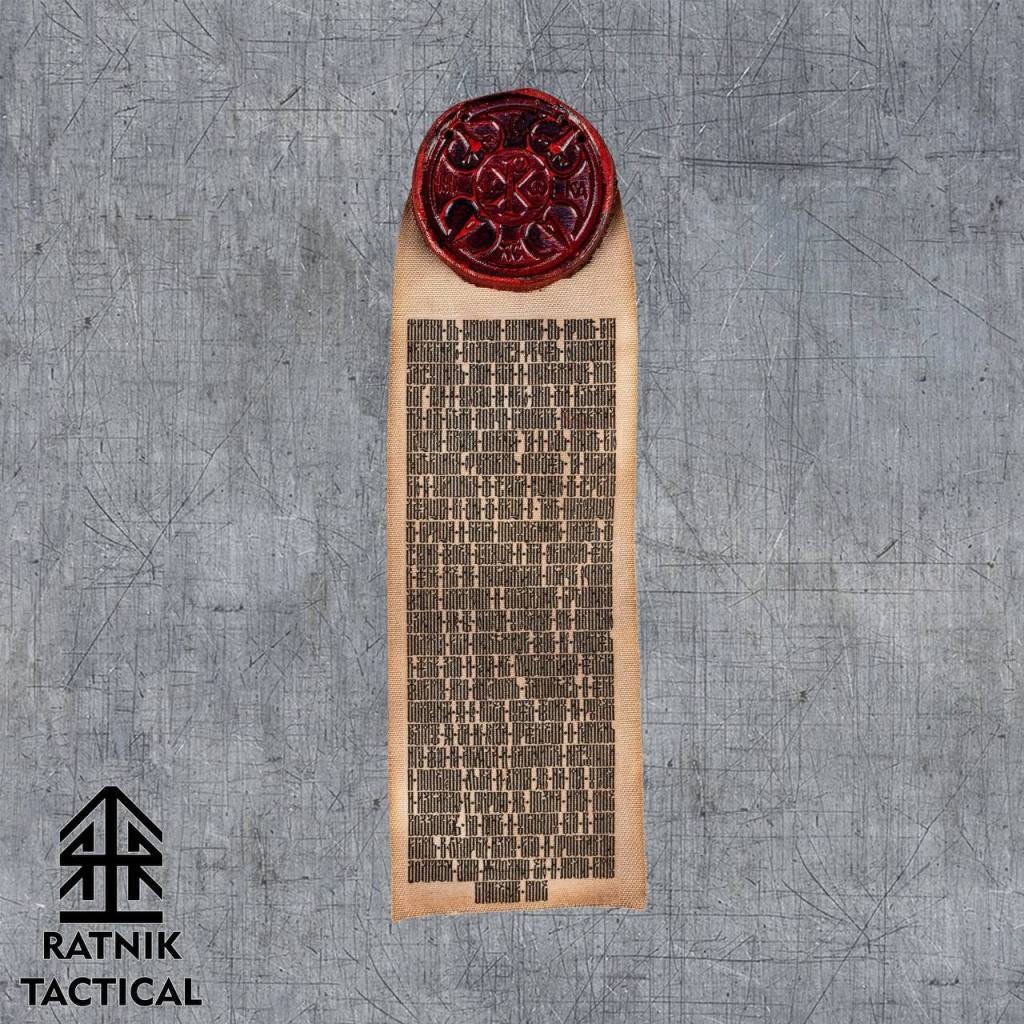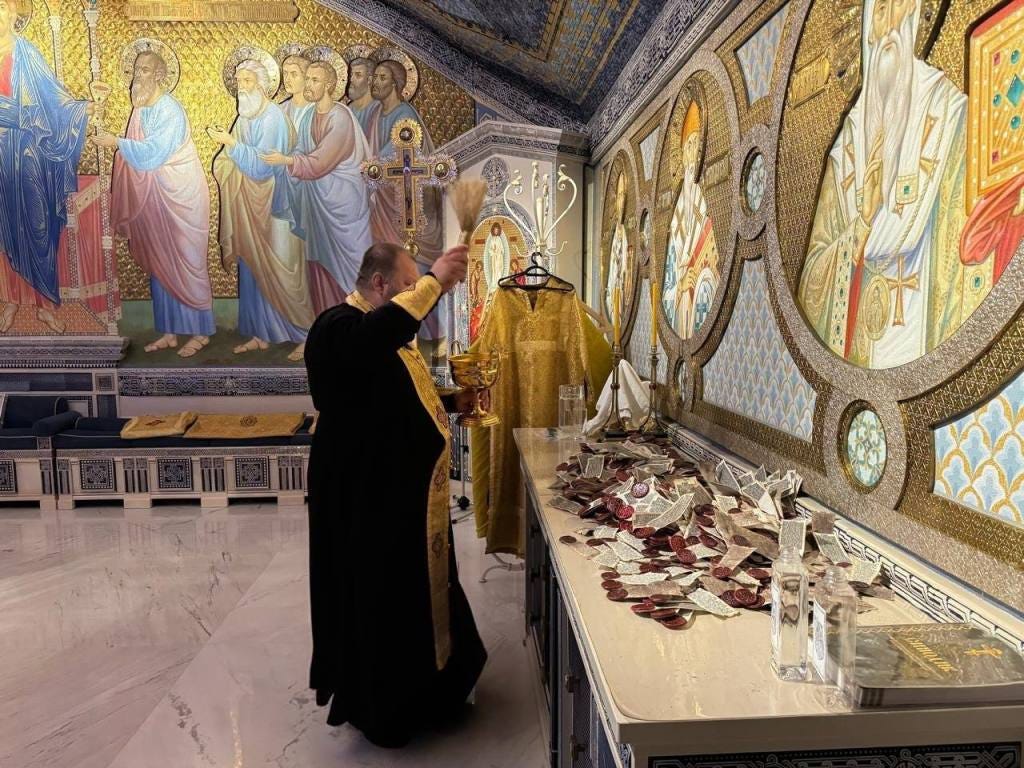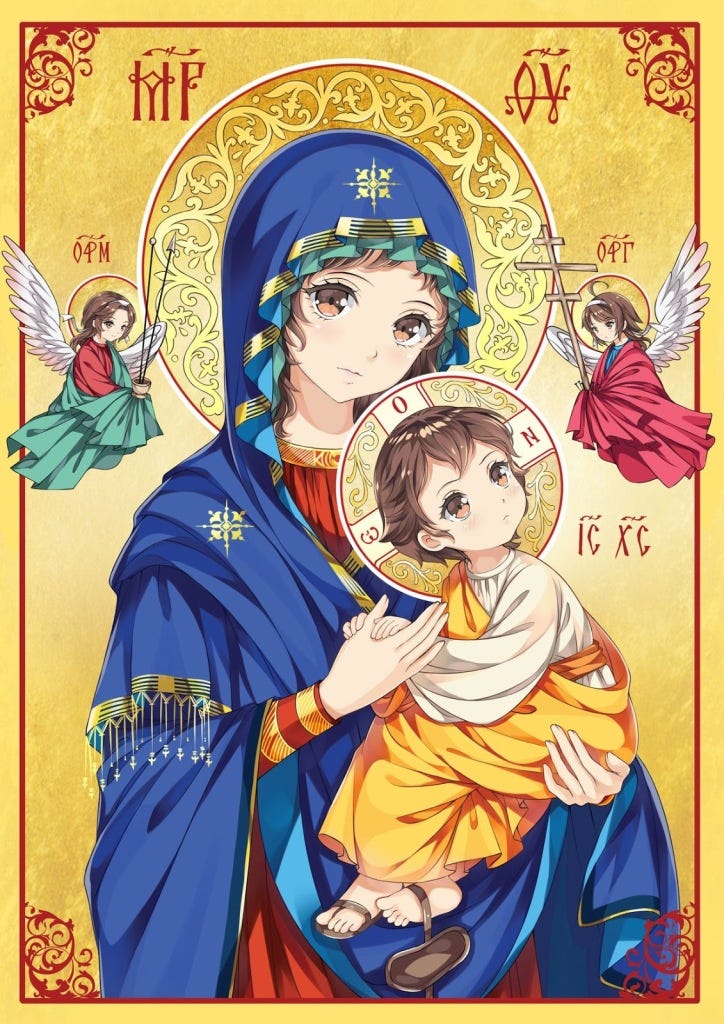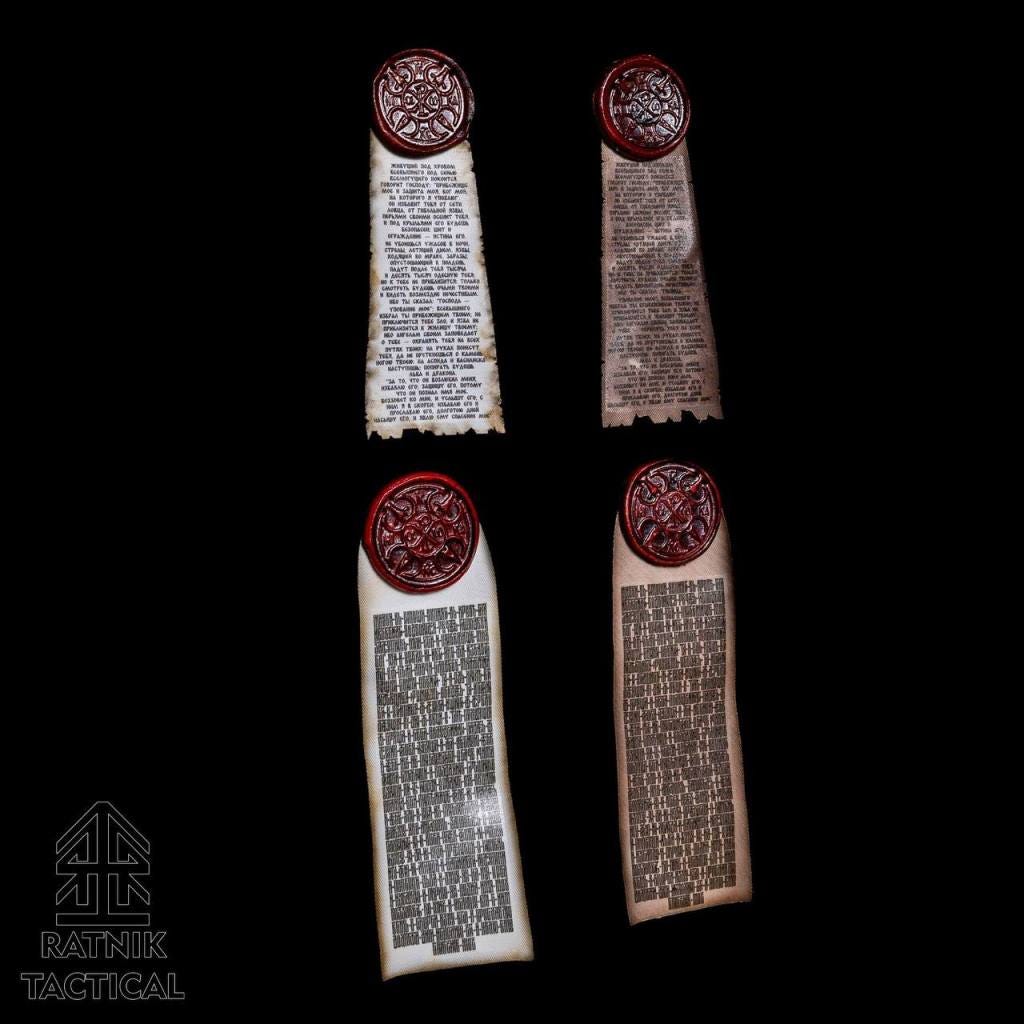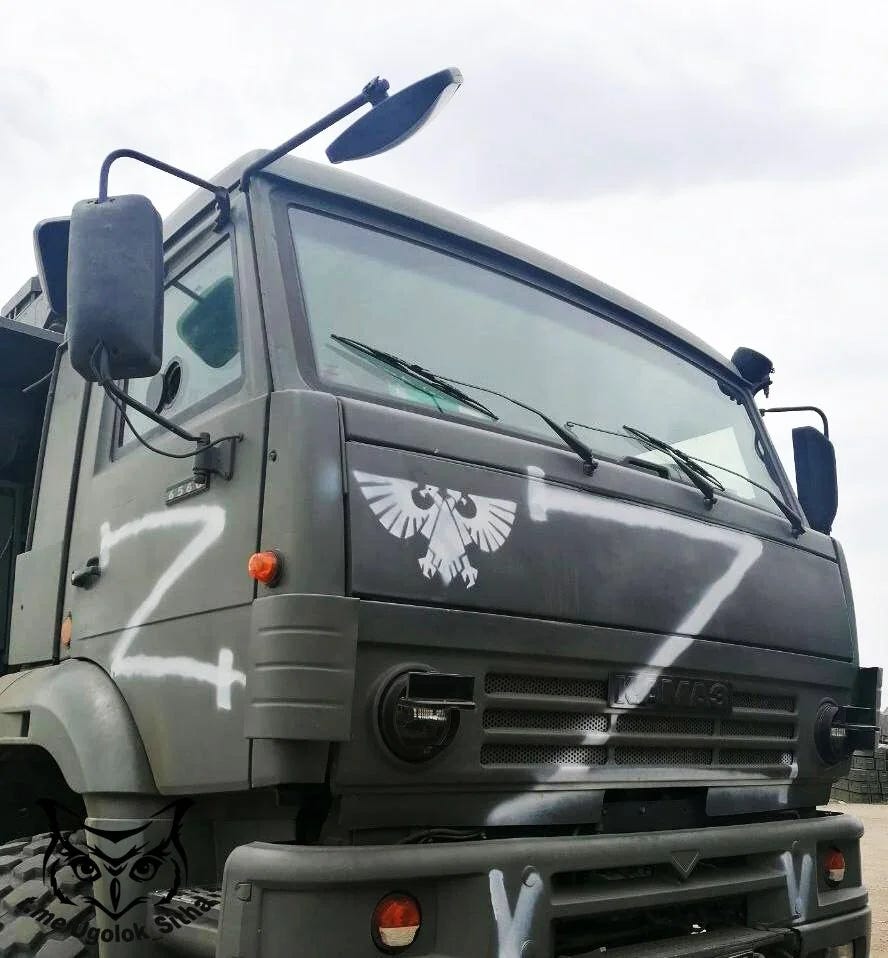On Ratnik Purity Seals
According to sources online, Ratnik Tactical, a Russian military protection gear company, has been producing blessed parchment seals for Russian soldiers fighting in the Ukraine. These particular seals are based upon similar seals from the Warhammer 40K tabletop game and universe. The Ratnik seals contain the ninety-first Psalm which reads as follows:
He that dwelleth in the secret place of the most High shall abide under the shadow of the Almighty. I will say of the Lord, He is my refuge and my fortress: my God; in him will I trust. Surely he shall deliver thee from the snare of the fowler, and from the noisome pestilence. He shall cover thee with his feathers, and under his wings shalt thou trust: his truth shall be thy shield and buckler. Thou shalt not be afraid for the terror by night; nor for the arrow that flieth by day; Nor for the pestilence that walketh in darkness; nor for the destruction that wasteth at noonday. A thousand shall fall at thy side, and ten thousand at thy right hand; but it shall not come nigh thee. Only with thine eyes shalt thou behold and see the reward of the wicked. Because thou hast made the Lord, which is my refuge, even the most High, thy habitation; There shall no evil befall thee, neither shall any plague come nigh thy dwelling. For he shall give his angels charge over thee, to keep thee in all thy ways. They shall bear thee up in their hands, lest thou dash thy foot against a stone. Thou shalt tread upon the lion and adder: the young lion and the dragon shalt thou trample under feet. Because he hath set his love upon me, therefore will I deliver him: I will set him on high, because he hath known my name. He shall call upon me, and I will answer him: I will be with him in trouble; I will deliver him, and honour him. With long life will I satisfy him, and shew him my salvation.
Psalm 91, KJV
In Warhammer, purity seals are inscribed with prayers and are affixed to armour and weapons, representing the bearers faith and morality. As an Orthodox Christian and someone who enjoys Warhammer, these Ratnik seals did not bother me. Warhammer 40K is popular in Russia, and we have already seen 40k iconography adorning Russian military equipment and on tactical patches. I see the Ratnik seals as leaning into that popularity, but also actually providing something of tangible value to Russian soldiers. Russian soldiers already receive similar items. The Tsar used to personally distribute “soldiers crosses” to his men, and such crosses are still available today. There also exists “prayer belts”, which are thin fabric belts which have prayers sown into them. I own one such belt which I had purchased at a ROCOR church before the war in Ukraine even began, so said belt is not a modern innovation (which some seem to believe). Therefore, one having a parchment containing Scripture hardly seems abnormal or wrong to me, even if the inspiration for the form it takes comes from a fictional setting. If people can be inspired to piety through settings like the Lord of the Rings, then I think it is acceptable for people likewise to be inspired by 40K (or even Dune).
However, my view was not largely shared. An online Orthodox commentator likened the Ratnik seals to non-canonical pseudo-icons, like those which display the Theotokos and Christ-child as animated characters with a distinctly Japanese styling. Example below:
He told me that although he does not take issue with Christianity influencing and inspiring culture and fantasy, he is concerned with the reverse. Both items essentially seek to accomplish the same end; that being to borrow an element of popular culture, enculturate it so as to attract to the Church those who may have not been inclined to do so before. However, where I do not see the Ratnik seals as being erroneous or heretical, I see the anime image as such. The incarnation was a real event, and therefore we are permitted to visually display it. Although one could argue that Byzantine style icons are problematic because Christ did not incarnate “in that style”, I would state that the Early Church was attempting to capture in image and symbol the reality of the Incarnation. As art styles developed, we do see shifts in iconographic style. However icons to be deemed as such (regardless of style) portray theology and the Truth of the Church as though they were themselves Scripture. The style just as the intention of the work dictate its message, which is why Byzantine, Russian, and some Western style icons can all be venerated. All these types of images both convey theology and at times have been shown acceptable to God through His enacting miracles through them. Icons, although beautiful, were not created for beauty’s sake and instead to express and demonstrate the Truth of our faith (O/orthodoxy). How Christ is depicted matters because Christ actually existed as a human on earth and to create images that do not attempt to capture that reality denies the physicality and Truth of the incarnation. This is why I have in the past denounced the existence of “ethnic icons”.1 Although I can be sympathetic to why such images exist (a black depiction of Christ shows that Christ incarnated and died for African people which is a true and a fine message), they undermine the reality of the Incarnation and render it exclusively symbolic. Furthermore, with the recent findings regarding the Shroud of Turin2, we have physical evidence demonstrating the ethnicity and physiognomy of Christ, which just so happens to look exactly like the icons of the Orthodox Church. Alas, an anime style icon does not seek to represent Christ or the Theotokos, and instead it represents the original icon from which it is based, so thus it cannot be said to be an icon but an icon of an icon, a symbol of a symbol. If someone wanted to own such an image I would not accuse them of error, one could even argue that such an image is pious, but would not be able to venerate it. I own what one could call secular or pious paintings of Christ that are beautiful and even convey Truth. However, the intention of such works is not to convey theology but rather to be the subject of the artists imagination, experiences, values, or beliefs. The artist is using the figure of Christ to convey his message or mood and not to capture the reality of the Christian faith. There is nothing wrong with this but such an image is not an icon and it can therefore not be venerated. If one were to venerate such an image, they would be through action saying that the artist’s image represents and symbolizes in its totality Christian Orthodoxy, which is unlikely for a secular artist even if they are Orthodox. Icons do not exist for the sake of the writer (an icon painter in Orthodoxy is called a writer and icons are said to be written) or his disposition but for the eternality they seek to capture.
I see the Ratnik seals as being “pious objects” and not items to be venerated. When all is said and done, these tokens are simply the words of Scripture printed in a novel fashion. If their form gives comfort or encouragement to soldiers, I do not see them as bad. I also do not see any erroneous theology being expressed by such tokens. In my discussion with the other commentator, he demonstrated concern over those who superficially come to Orthodoxy for reasons aesthetic. This has recently been more of a Catholic phenomenon, with (presumably) young men employing crusader iconography and making memes about Rome’s more masculine past. However, there have likewise been Orthodox converts and inquirers who have embraced the more superficial3 elements of Orthodoxy as well. This invented “personalized” view of Orthodoxy most often results in a convert becoming disheartened with the Church as it actually is and results in apostasy. So yes, we do need to take care that just because Orthodoxy “looks cool”, is “based”, and so on, that we do not make these the reasons why someone is to convert. That being said, there is something to be said about how aesthetics can be used to pique the interests of people inclined to such things. This is essentially what the monks of the Saint Hermans Brotherhood have done with their publications and website Death to the World4. In attempting toenculturate aspects of 1980’s punk culture and rebelliousness, they have created an organization which attempts to bring modern youth out of the grips of nihilism and into the Church, steering their natural inclination towards rebellion into rebellion against the spirit of the age. One may argue that Death to the World does not represent Orthodoxy, and may even send a harmful message, but I disagree if not for the reason that it is run by monks who are in good standing with the Church and has existed for almost 40 years. Likewise, these seals of Ratnik are sanctioned by the Russian Orthodox Church, and are blessed by an Orthodox priest within the Main Cathedral of the Russian Armed Forces5 no less.
Warhammer 40K is itself largely an aesthetic. The books, lore, and game serve to sell models and paints, and people are drawn to certain factions and miniatures largely because of how they look. Warhammer can also be whatever the customer wants it to be, with many customers creating custom armies with invented lore. I, for one, appreciate the existence of the Knights of Byzantium for example, and have attempted to create units from said chapter. The Ratnik seals borrow from the aesthetic of Warhammer to create something tangible and real with meaning. To call them “purity seals” or “seals” at all is really a misnomer and disingenuous because these “prayer tokens” do not purport to function in the manner that the seals from Warhammer do. I liken Ratnik’s product to purity seals because that is what they were inspired by, yet they are not those as such. If Warhammer had never existed, these prayer tokens would garner no more controversy than that of the Russia prayer belts or similar such pious items. The tokens are in and of themselves not problematic regardless of what brought about their inspiration. The icon in anime style, in contrast, would be unacceptable regardless of if anime or manga had existed because it fails to be what an icon is. Of course, the image is only problematic if one would seek to employ it as a venerable object, and since no one to my knowledge holds the prayer token in such esteem it does not do damage to Orthodox theology or the Church.
1https://godkingandnation.wordpress.com/2020/10/11/the-race-of-jesus-the-theotokos-their-depictions-and-why-it-matters/
2https://godkingandnation.wordpress.com/2024/08/22/the-shroud-of-turin/
3I do not wish to imply that Orthodoxy contains elements that are superfluous but rather, that fixation on aesthetics or “Orthodoxy being based” alone can result in one failing to accept Orthodoxy for what it actually is, (Christ’s Church) and thus fail to grow spiritually.
https://deathtotheworld.com/
5Which ironically (or maybe deliberately) has been described as a building reminiscent to those of the Warhammer 40K universe.




